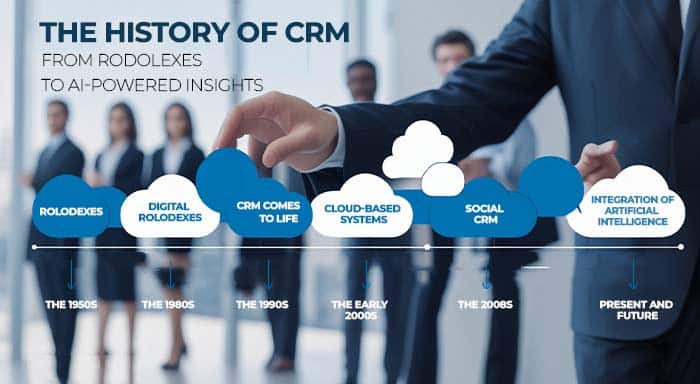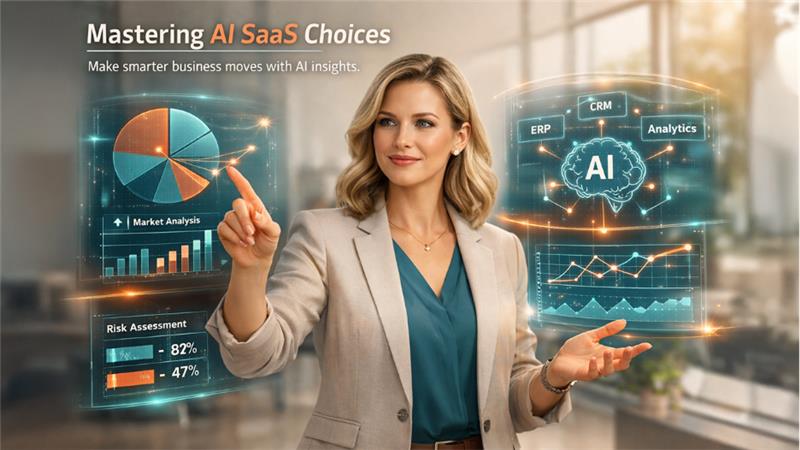Let us suppose you are running a business in the 1950s where customer data is stored in stacks of paper invoices, notebooks filled in cabinets, or hidden in bulky Rolodex. In the fast-paced world of today, such effective innovations revolutionized businesses for managing customer data and managing their relationships. In such innovations, customer relationship management (CRM) comes into play with a huge role in this transformation. CRM has become an indispensable tool for every business, which highlights its importance and necessity. But how did we get here? Let’s take a look at the history of CRM and how it transforms manual record-keeping systems into today’s intelligent system.
What is CRM?
CRM, or customer relationship management, is software that helps businesses improve and manage their relationship with customers. This system is used for storing customer details such as contact information, sales, and interactions and automating tasks like sales and marketing. CRM reduces the need for multiple applications, such as spreadsheets, databases, and other applications that many businesses use to collect customer data.
The Detailed CRM History: From the 1950s to the Present
The 1950s: The Pre-digital Era and Emergence of Rolodexes
Before the emergence of computers, customer relationships were built on personal connections and paper invoices, relying on manual methods that were slow and error-prone. Business owners relied on hard-working and engaging salespeople who promoted their products by physically interacting one by one and using old-fashioned charm to engage their customers.
Here is the term Rolodex, introduced in the 1950s by “Hildaur Neilsen," which was a manual contact management tool that keeps all the interaction between customers and business. This early stage in the history of CRM sets the foundation for future advancements. Over time, as business expands, keeping track of all these interactions becomes an impossible task on these manual systems.
The 1980s: Introduction to Database Marketing or Digital Rolodexes
The early 1980s had become a game changer—businesses shifted from direct marketing to database marketing, which means businesses now work on digital databases over paper-based records. This allows businesses to store and retrieve customer details and transform their communication process to boost conversion rates. In 1987, the first digital software, ACT, was released, which was the first digital Rolodex used to store customer information electronically.
This innovation proved to be a transformative approach in the history of CRM for marketers to segment the audience as per their preferences and demands and offer them personalised solutions.
The 1990s: CRM Comes to Life
By the 1990s, businesses understood that storing customer data was not enough—they needed insights. Where the emerging technologies are kept for developing software that manages customer data efficiently, the invention of the first customer management system comes into play. In 1995, the term “CRM—Customer Relationship Management” was introduced by Siebel Systems, which could track customer interaction, behavior, and preferences that help businesses gain insights and make informed decisions.
Then, in 1993, Siebel introduced a game changer—Salesforce, which was the first cloud-based CRM that allowed salespeople to access customer data easily from anywhere via the internet. This was just the beginning of a streamlined, flexible system that paved the way for the modern history of CRM, which eliminates the need for expensive installation.
The Early 2000s: CRM Becomes Necessity with the Growth of Cloud-Based Systems
By the early 2000s, CRM became a must-have tool after entering the big companies in the scene, which gives significance to the history of CRM. Microsoft and Oracle are making it widely accessible with Microsoft Business Solutions Customer Relationship Management 1.0. With its integration with the cloud, it offers various features such as customer segmentation, automated workflows, and real-time analytics
SugarCRM, a free and open-source project developed by Clint Oram, John Roberts, and Jacob Taylor in 2004, allows companies to use CRM efficiently and cheaply. They built and hosted the software on a repository for free and open-source applications—source forage by using their prior experience at IBM and Hewlett-Packard. The software gained impressive plurality and added another layer in the brief history with 5000 downloads in the first month, and the organisation used this tool to simplify their customer journey process.
The 2008s: Social CRM
In the late 2000s, businesses started using social media channels to manage customer interaction across platforms like Facebook and Twitter. The use of social media transforms the CRM strategy from transactional to engaging client relationship management. This is often called social CRM—companies utilize it to engage with customers in real-time and track online conversion to tailor service and marketing strategy according to their needs and preferences.
Top 16 Open Source CRM Software
Present and Future: Integration of Artificial Intelligence
The integration of artificial intelligence and CRM systems improves business strategies and helps them automate repetitive tasks to provide customer insights before they arise. Today, understanding customer needs, project management, customer service, and even HR teams use AI-powered CRM tools to streamline processes and boost efficiency.
Predictive analytics used previous customer data to identify their unique requirements, behaviour, and future needs, and it also helped businesses get a 360-degree view of their customers to provide personalised and tailored solutions.
Looking ahead, CRM systems are not about managing relationships—it is about deepening into customer insights to improve their experience.
With the growing technological advancements, many industry-driven solutions like plumbing CRM software are introduced as game-changer solution. These systems provide a vast array of features designed to meet field service requirements. This includes job scheduling, service history monitoring, and route upgrading to help plumbing businesses enhance efficiency and customer happiness.
Conclusion
Looking back to CRM history, from handwritten notes to the creation of modern-day CRM with AI-powered predictions, the journey has evolved dramatically. And the best thing? It has transformed the way businesses understand their customer’s needs and interact with customers to make strong and valuable relationships with them. Whether you are a small startup or a large enterprise, understanding customer needs and preferences is the key to success. With AI and machine learning, CRM is advancing with more updates to brighten the future of customer relationships. The history of CRM proves each technological innovation fills the gap between businesses and customers
Author’s BIO

With 15 years of experience in CRM, I specialize in developing plugins for SuiteCRM and SugarCRM. My notable creations include SuiteCRM Email to Lead, SuiteCRM BCC Archiver, and SugarCRM Mailchimp. My expertise lies in enhancing CRM functionalities to drive business efficiency and growth.
Additionally, I create content on YouTube, sharing insights and tutorials on CRM solutions to help businesses enhance their efficiency and growth.



